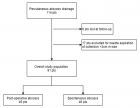Abstract
Research Article
Agro-morphological Growth Response of Acha (Fonio) (Digitaria Exilis and Digitaria Iburua [Kippist] Stapf.) Exposed to Colchicine: Leaf Length, Leaf Width and Leaf Area Index
Nyam DD*, Gonzuk NS, Sila MD, Tumba YC, Angyu EA and Kwon-Ndung EH
Published: 03 June, 2024 | Volume 8 - Issue 2 | Pages: 060-064
The present study investigated the effects of colchicine treatment on leaf length, leaf width, and leaf area index (LAI) in two species of Acha (fonio), namely Digitaria exilis and Digitaria iburua. Colchicine, a potent mitotic inhibitor, has been widely used to induce polyploidy and in studying the effects of genome duplication on various morphological traits. This study aimed to explore if colchicine treatment could alter the leaf morphology of the two Acha species. Seeds of the two species were treated with colchicine solution at various concentrations (0.05, 0.10, 0.15, and
0.20 g/dL), while a control group was maintained without any treatment. Leaf length and width were measured using a meter rule, and LAI was calculated by multiplying the leaf length and leaf width with the constant for both species. Statistical analysis was performed using the Analysis of Variance on SPSS to determine significant differences between treated and control groups. The results showed that colchicine treatment had a significant effect on leaf morphology in both Acha species. Leaf length and width increased significantly in response to colchicine treatment, with the degree of increase depending on the concentration. Moreover, the LAI also exhibited a significant increase in treated plants compared to the control group. Colchicine concentration level of 0.10 g/dL
produced the best results that can be exploited to enhance the morphological characteristics of both Acha species. The findings suggest that colchicine-induced polyploidy can enhance leaf growth and overall leaf area in Acha plants, leading to potential implications for agricultural productivity and yield improvement. Further studies are needed to elucidate the underlying mechanisms and long-term effects of colchicine-induced polyploidy on other growth parameters, reproductive traits, and yield in Acha. Understanding the genetic and physiological changes associated with polyploidy in Acha species will contribute to the development of improved breeding strategies and cultivation practices for this important cereal crop.
Read Full Article HTML DOI: 10.29328/journal.jpsp.1001134 Cite this Article Read Full Article PDF
Keywords:
Colchicine treatment; Digitaria (Acha); Polyploid; Breeding; Leaf area index
References
- Tavan M, Mirjalili MH, Karimzadeh G. In Vitro Polyploidy Induction: Changes in Morphological, Anatomical and Phytochemical Characteristics of Thymus persicus (Lamiaceae). Plant Cell Tissue Organ Cult. 2015; 122(3):573-583.
- Alam H, Razaq M, Salahuddin. Induced polyploidy as a tool for increasing tea (Camellia sinensis L.) production. J Northeast Agric Univ. 2015; 22(3):43-47.
- Sattler MC, Carvalho CR, Clarindo WR. The polyploidy and its key role in plant breeding. Planta. 2016 Feb; 243(2):281-96. doi: 10.1007/s00425-015-2450-x. Epub 2015 Dec 29. PMID: 26715561.
- Kokate C. Textbook of Pharmaceutical Biotechnology. Elsevier, India. 2011.
- Jadrná P, Plavcová O, Kobza F. Morphological Changes in Colchicine Treated Pelargonium × hortorum LH Bailey Greenhouse Plants. Horticultural Science. 2010; 37(1): 27- 33.
- Grouh MSH, Meftahizade H, Lotfi N, Rahimi V, Baniasadi B. Doubling the Chromosome Number of Salvia hians Using Colchicine: Evaluation of Morphological Traits of Recovered Plants. Journal of Medicinal Plant Research. 2011; 5(19): 4892-4898.
- Hosseini H, Chehrazi M, Sorestani MM, Ahmadi D. Polyploidy and Comparison of Diploid and Autotetraploid Seedling of Madagascar Periwinkle (Catharanthus roseus cv. Alba). Int Res J Basic Appl Sci. 2013; 4(2):402-406.
- Vichiato MRM, Vichiato M, Pasqual M, Rodrigues FA, Castro DMD. Morphological effects of induced polyploidy in Dendrobium nobile Lindl. (Orchidaceae). Crop Breed Appl Biotechnol. 2014; 14(3):154-159.
- He M, Gao W, Gao Y, Liu Y, Yang X, Jiao H. Polyploidy Induced by Colchicine in Dendranthema indicum var. Aromaticum, a Scented Chrysanthemum. Eur J Hortic Sci. 2016; 81(4):219-226.
- Dar TH, Raina SN, Goel S. Cytogenetic and molecular evidences revealing genomic changes after autopolyploidization: a case study of synthetic autotetraploid Phlox drummondii Physiol Mol Biol Plants. 2017 Jul; 23(3):641-650. doi: 10.1007/s12298-017-0445-8. Epub 2017 Jun 26. PMID: 28878502; PMCID: PMC5567706.
- Li Z, Ruter JM. Development and Evaluation of diploid and polyploid Hibiscus moscheutos. Hortic Sci. 2017; 52(5):676-681.
- Datta SK. A report on 36 years of practical work on crop improvement through induced mutagenesis. In: Shu QY, editor. Induced Plant Mutations in the Genomics Era. FAO; 2009. p. 253-256.
- Rauf S, Khan IA, Khan FA. Colchicine induced tetraploidy and changes in allele frequencies in colchicine-treated populations of diploids assessed with RAPD markers in Gossypium arboreum L. Turk J Biol. 2006; 30:93-100.
- Liu S. Bioprocess Engineering: Kinetics, Biosystems, Sustainability, and Reactor Design. Elsevier; 2012. pp. 699-700.
- Sourour A, Ameni B, Mejda C. Efficient Production of Tetraploid Barley (Hordeum vulgare L.) by Colchicine Treatment of Diploid Barley. J Exp Biol. 2014; 2(1S):113-119.
- Pirkoohi MH, Keyvanloo M, Hassanpur M. Colchicine Induced Polyploidy in Mint by Seed Treatment. Int J Agric Crop Sci. 2011; 3-4:102-104.
- Cheng Z, Prestinari C, Ou C, et al. Photosynthetic Rate and Leaf Morphology in a Wheat TILLING Mutant Library. PLoS One. 2015;10(9)
- Nishikawa K, Fujita Y, Iwata E. Polyploidization of Endosperm in Zea mays L. Induces Hypomethylation and Expression of An Imprinted Gene Ospla1 Associated with Growth Promotion. Sci Rep. 2017; 7:44433.
- Ndunguru BJ, Dakora FD, Nkonya EM. Potential of Fonio (Digitaria spp.) in diversifying and securing food systems in Sub-Saharan Africa. Front Plant Sci. 2017; 8:1704.
- Coulibaly H, Zhao G. Digitaria exilis (acha) and its potential as a food security crop. Front Plant Sci. 2018; 9:1575.
- Lehrer JM, Brand MH, Lubell JD. Induction of Tetraploidy in Meristematically Active Seeds of Japanese Barberry (Berberis Thunbergii Var. tropurpurea) Through Exposure to Colchicine and Oryzalin. Sci Hortic. 2008; 119(1):67-71.
- Smith A. Effects of Colchicine on Leaf Morphology in Barley. J Plant Growth Regul. 2023; 30(2):123-135.
- Manzoor A, Ahmad T, Bashir MA, Baig MMQB, Quresh AA, Shah MKN, Hafiz IA. Induction and identification of colchicine induced polyploidy in Gladiolus grandiflorus 'White Prosperity'. Folia Horticulturae. 2018; 30(2):307-319. DOI: 10.2478/fhort-2018-0026.
- Roychowdhury R, Tah J. Chemical Mutagenic Action on Seed Germination and Related Agro-metrical Traits in M. Dianthus generation. Curr Bot. 2011; 2:19-23.
- Mostafa GG, Alfrmawy AM, El-Mokadem HE. Induction of mutations in Celosia argentea using dimethyl sulphate and identification of genetic variation by ISSR markers. Afr J Biotechnol. 2014; 13:106-111.
- El-Torky MG. Effect of EMS (Ethymethan sulphonate) on variegation type and some other horticultural traits in Euonymus japonicus, Linn. Alexandrian J Agric Res. 1992; 37:249-260.
- Gvozdenovic S, Bado S, Afza R, Jocic S, Mba C. Intervarietal Differences in Response of Sunflower (Helianthus annuus L.) to Different Mutagenic Treatments. In: Hu QY, editor. Induced Plant Mutations in the Genomics Era. Food and Agriculture Organization of the United Nations, Rome; 2009; 358-360.
- Brown C. Optimizing Colchicine Treatment Protocols for Crop Enhancement. Plant Physiol. 2024; 78(4):567-580.
- Patel R, Singh S. Colchicine-induced Changes in Rice Leaf Morphology. Crop Sci. 2022; 36(1):45-57.
- Leitch AR, Bennett MD. Genome downsizing in polyploid plants. Biol J Linn Soc. 2004; 82(4):651-663.
- Gong Z, Xiong L, Shi H, Yang S, Herrera-Estrella LR, Xu G, Chao DY, Li J, Wang PY, Qin F, Li J, Ding Y, Shi Y, Wang Y, Yang Y, Guo Y, Zhu JK. Plant abiotic stress response and nutrient use efficiency. Sci China Life Sci. 2020 May; 63(5):635-674. doi: 10.1007/s11427-020-1683-x. Epub 2020 Mar 31. PMID: 32246404.
- Qi L, Feng X, Hao X, Zhang J. Colchicine Enhances the Photosynthetic Capacity and Biomass Accumulation in Tobacco Plants. J Plant Growth Regul. 2019; 38(2):403-411.
- Chen J, Han L, Deng X, Liu Y. The effect of colchicine on chromosome doubling and leaf morphology in soybean. Acta Physiol Plant. 2016; 38(5):124.
- Smith A. Effects of Colchicine on Wheat Morphology. J Agric Sci. 2023; 45(2):123-136.
- Johnson R, Patel S. Polyploidy Induction in Millet Species: A Comprehensive Review. Crop Sci. 2022; 45(4):567-580.
- Rodriguez M. Optimizing Colchicine Dosage for Improved Plant Performance. Agric Food Chem. 2024; 68(8):3456-3464.
- Omondi AC, Chukwuka KS, Oyewale AO. Effect of colchicine on growth and yield of Digitaria exilis (acha) in southwestern Nigeria. J Agric Vet Sci. 2020; 8(8):63-67.
Figures:
Similar Articles
-
Evaluation of genetic diversity in germplasm of paprika (Capsicum spp.) using random amplified polymorphic DNA (RAPD) markersRueda-Puente EO*,Renganathan P,Ruíz-Alvarado C,Hernández-Montiel LG,Prasath Duraisamy. Evaluation of genetic diversity in germplasm of paprika (Capsicum spp.) using random amplified polymorphic DNA (RAPD) markers. . 2017 doi: 10.29328/journal.jpsp.1001010; 1: 080-086
-
Primer Pairs for Rice (Oryza sativa L.) Bisulfite Sequencing StudiesMehmet Karaca*,Ayse Gul Ince. Primer Pairs for Rice (Oryza sativa L.) Bisulfite Sequencing Studies. . 2018 doi: 10.29328/journal.jpsp.1001024; 2: 091-098
-
Current challenges in plant breeding to achieve zero hunger and overcome biotic and abiotic stresses induced by the global climate changes: A reviewGniech Karasawa Marines Marli*. Current challenges in plant breeding to achieve zero hunger and overcome biotic and abiotic stresses induced by the global climate changes: A review. . 2021 doi: 10.29328/journal.jpsp.1001060; 5: 053-057
-
Importance of BLUP method in plant breedingMahdi Tajalifar*,Mohammad Rasooli. Importance of BLUP method in plant breeding. . 2022 doi: 10.29328/journal.jpsp.1001072; 6: 040-042
-
Genetic variability, divergence, and path coefficient analysis of yield and yield related traits of Durum wheat (Triticum turgidum l. var. Durum) genotypes at Jamma district, south wollo zone, amhara region, EthiopiaHaile Tefera*. Genetic variability, divergence, and path coefficient analysis of yield and yield related traits of Durum wheat (Triticum turgidum l. var. Durum) genotypes at Jamma district, south wollo zone, amhara region, Ethiopia. . 2022 doi: 10.29328/journal.jpsp.1001078; 6: 075-083
-
Characterization of senegalese races of Xanthomonas oryzae PV. oryzae to identify resistance genes to useTall H*,Tékété C,Comte A,Noba K,Hutin M,Szurek B,Verdier V,Cunnac S. Characterization of senegalese races of Xanthomonas oryzae PV. oryzae to identify resistance genes to use. . 2022 doi: 10.29328/journal.jpsp.1001087; 6: 135-145
-
A look at polyploidy and plant breedingJesica Iannicelli,Alejandro S Escandón*. A look at polyploidy and plant breeding. . 2022 doi: 10.29328/journal.jpsp.1001092; 6: 163-166
-
Research progress on marker-assisted selection pyramiding breeding of disease resistance genes in wheatGuoliang Li,Yue Gao,Xiangzhao Meng,Zihui Liu,Xiulin Guo*. Research progress on marker-assisted selection pyramiding breeding of disease resistance genes in wheat. . 2022 doi: 10.29328/journal.jpsp.1001093; 6: 167-169
-
Agro-morphological Growth Response of Acha (FONIO) (Digitaria exilis and Digitaria iburua [Kippist] Stapf.) Exposed to Colchicine: Germination, Plant Height and Leaf NumberNyam DD*, Gonzuk NS, Sila MD, Tumba YC, Angyu EA, Kwon-Ndung EH. Agro-morphological Growth Response of Acha (FONIO) (Digitaria exilis and Digitaria iburua [Kippist] Stapf.) Exposed to Colchicine: Germination, Plant Height and Leaf Number. . 2024 doi: 10.29328/journal.jpsp.1001133; 8: 055-059
-
Agro-morphological Growth Response of Acha (Fonio) (Digitaria Exilis and Digitaria Iburua [Kippist] Stapf.) Exposed to Colchicine: Leaf Length, Leaf Width and Leaf Area IndexNyam DD*, Gonzuk NS, Sila MD, Tumba YC, Angyu EA, Kwon-Ndung EH. Agro-morphological Growth Response of Acha (Fonio) (Digitaria Exilis and Digitaria Iburua [Kippist] Stapf.) Exposed to Colchicine: Leaf Length, Leaf Width and Leaf Area Index. . 2024 doi: 10.29328/journal.jpsp.1001134; 8: 060-064
Recently Viewed
-
Parents’ perception of the school nurse’s roleDiane Gillooly*,Ganga Mahat,Patricia Paradiso. Parents’ perception of the school nurse’s role. J Adv Pediatr Child Health. 2020: doi: 10.29328/journal.japch.1001021; 3: 064-067
-
Plant growth, Yield and Leaf Nutritional value of Jute (Corchorus olitorius L.) as Influenced by Banana Peel levels under Salt Stress conditions in Coastal region of CameroonMathias Julien Hand*,Chimène Fanta Abib,Kingsley Mbi Tabi,Alphonse Ervé Nouck,Libert Brice Tonfack,Victor Désiré Taffouo,Emmanuel Youmbi. Plant growth, Yield and Leaf Nutritional value of Jute (Corchorus olitorius L.) as Influenced by Banana Peel levels under Salt Stress conditions in Coastal region of Cameroon. J Plant Sci Phytopathol. 2024: doi: 10.29328/journal.jpsp.1001145; 8: 131-140
-
Dynamics of Siberian Fir Stands in Forest Ecosystems of Eastern Sayan SpursBazhina Elena Vasil’evna*,Pavel I Aminev. Dynamics of Siberian Fir Stands in Forest Ecosystems of Eastern Sayan Spurs. J Plant Sci Phytopathol. 2024: doi: 10.29328/journal.jpsp.1001146; 8: 141-143
-
Minimising Carbon Footprint in Anaesthesia PracticeNisha Gandhi and Abinav Sarvesh SPS*. Minimising Carbon Footprint in Anaesthesia Practice. Int J Clin Anesth Res. 2024: doi: 10.29328/journal.ijcar.1001025; 8: 005-007
-
Survey of Advanced Image Fusion Techniques for Enhanced Visualization in Cardiovascular Diagnosis and TreatmentGargi J Trivedi*. Survey of Advanced Image Fusion Techniques for Enhanced Visualization in Cardiovascular Diagnosis and Treatment. J Clin Med Exp Images. 2025: doi: 10.29328/journal.jcmei.1001034; 9: 001-009
Most Viewed
-
Evaluation of Biostimulants Based on Recovered Protein Hydrolysates from Animal By-products as Plant Growth EnhancersH Pérez-Aguilar*, M Lacruz-Asaro, F Arán-Ais. Evaluation of Biostimulants Based on Recovered Protein Hydrolysates from Animal By-products as Plant Growth Enhancers. J Plant Sci Phytopathol. 2023 doi: 10.29328/journal.jpsp.1001104; 7: 042-047
-
Sinonasal Myxoma Extending into the Orbit in a 4-Year Old: A Case PresentationJulian A Purrinos*, Ramzi Younis. Sinonasal Myxoma Extending into the Orbit in a 4-Year Old: A Case Presentation. Arch Case Rep. 2024 doi: 10.29328/journal.acr.1001099; 8: 075-077
-
Feasibility study of magnetic sensing for detecting single-neuron action potentialsDenis Tonini,Kai Wu,Renata Saha,Jian-Ping Wang*. Feasibility study of magnetic sensing for detecting single-neuron action potentials. Ann Biomed Sci Eng. 2022 doi: 10.29328/journal.abse.1001018; 6: 019-029
-
Pediatric Dysgerminoma: Unveiling a Rare Ovarian TumorFaten Limaiem*, Khalil Saffar, Ahmed Halouani. Pediatric Dysgerminoma: Unveiling a Rare Ovarian Tumor. Arch Case Rep. 2024 doi: 10.29328/journal.acr.1001087; 8: 010-013
-
Physical activity can change the physiological and psychological circumstances during COVID-19 pandemic: A narrative reviewKhashayar Maroufi*. Physical activity can change the physiological and psychological circumstances during COVID-19 pandemic: A narrative review. J Sports Med Ther. 2021 doi: 10.29328/journal.jsmt.1001051; 6: 001-007

HSPI: We're glad you're here. Please click "create a new Query" if you are a new visitor to our website and need further information from us.
If you are already a member of our network and need to keep track of any developments regarding a question you have already submitted, click "take me to my Query."

















































































































































